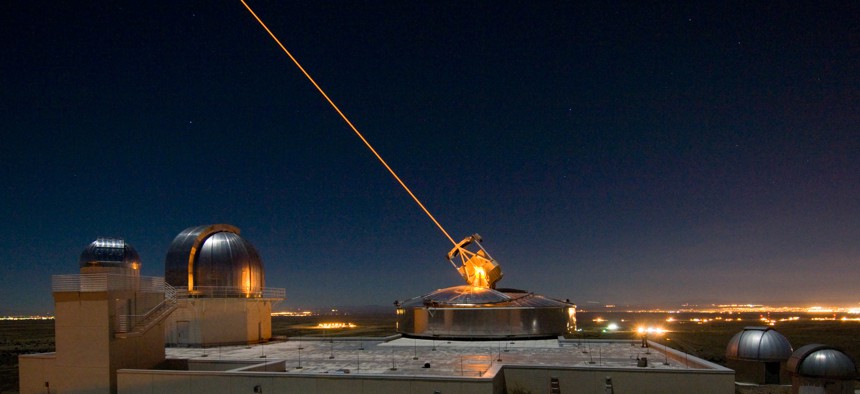
The Sodium Guidestar at the Air Force Research Laboratory Directed Energy Directorate's Starfire Optical Range. AFRL
Laser Weapons: A Blueprint for Adding Them to the Force
Directed energy weapons promise a new advantage — if the U.S. accelerates development of related technologies and doctrine.
The country that is first to develop and field battlefield lasers will have a distinct military advantage. Directed energy weapons promise to complement kinetic weapons and help fight off various emerging threats, such as swarms of drones, fast attack boats, and cruise missiles. And the recently released Missile Defense Review calls for studying the potential of space-based lasers to intercept ballistic missiles.
But to achieve that advantage, the United States must develop lasers and other directed energy weapons sooner rather than later, and do so at scale to put them into the hands of our warfighters in a meaningful way. This week’s Directed Energy Summit, the first major gathering of its kind since the release of the Missile Defense Review, offers a forum where top national security leaders and policymakers can seize the momentum.
Related: Pentagon Wants to Test A Space-Based Weapon in 2023
Related: China, Russia Building Attack Satellites and Space Lasers: Pentagon Report
Related: Pentagon to Study Putting Anti-Missile Laser Weapons in Space
The question is, how? Here’s a 10-point blueprint designed to get us going in the right direction.
- The Defense Department must scale up laser power and improve beam quality development. The pace of maturing these capabilities is not technology-limited – it is funding-limited. Therefore, we should increase directed energy funding to between $2 billion to $3 billion per year.
- We should also take further action to reduce the size, power, weight, and cost requirements of these weapons. The Office of the Secretary of Defense, for example, should establish and fund a separate program toward that end – and to focus broadly on improving laser weapon lethality. MDA laser programs should be fully funded to increase laser power levels for high-altitude and space-based applications.
- We must provide warfighters with tactical decision aids to ensure they know how and when to use these weapons. This will go far toward instilling confidence in our warfighters that these weapons will be effective in combat against multiple threats.
- While a tremendous amount of work has been done, we should also conduct further research to improve our understanding of laser lethality and reliability across an increasing range of weather and atmospheric conditions. This research should also focus on minimizing any collateral damage.
- We need to accelerate our acquisition of these capabilities. DoD takes more than 16 years, on the average, to bring new technologies from statement of need to deployment. But there are several examples of this timeline being dramatically shortened, such as the Navy’s Rapid Prototyping Experimentation and Demonstration program for mission-critical capabilities and the use of specialized acquisition authorities by the MDA. DoD should use such accelerated processes for directed energy development and deployment.
- DoD must signal a long-term commitment to lasers, so the industrial base will know there will be a market for its products in the coming years. In doing so, DoD should prepare, and encourage, the industrial base to support the rising need for first-, second-, and third-tier suppliers.
- DoD should fully fund existing tests at sea, on land, and in the air – and there are many. Navy projects, such as the Laser Weapons System aboard the USS Ponce, have already shown that lasers can shoot down drones and collect surveillance data at long range. Other higher-powered Navy lasers, such as the HELIOS system, are in development and will be on a surface combatant next year. Meanwhile, the Army has tested a 5-kilowatt laser mounted on a Stryker combat vehicle and aims to field-test a 50-kW Stryker-mounted laser in 2021, with a goal of fielding it by 2023. Plus, the Air Force’s SHiELD project is developing 50-kW air-based lasers to produce a fighter-compatible weapon for use by 2021.
- All parties involved in laser deployment should talk to each other. DoD needs to better articulate its requirements for deployable lasers. But also, the industrial base must interface better with DoD and its leadership to increase understanding of innovative laser weapon capabilities.
- We must also prioritize warfighter training. There is currently no established laser weapon training pipeline, and that’s because lasers have no formal programs of record. Once these are set up, training must follow. To assist in establishing such programs, we should encourage wargames and operational analysis to investigate and better articulate the battlefield benefits of lasers.
- DoD should adapt command-and-control functions to address rapidly evolving threats, such as hypersonics, to reduce the engagement times of defensive systems. Very short engagement timelines will likely necessitate the incorporation of artificial intelligence capabilities to help the U.S. leverage the speed-of-light engagement that directed energy weapons offer.
These are the steps we can take to bring laser prototype systems to our warfighters. Our brave men and women confront dangerous threats across all physical domains – land, air, sea, and space – and need nothing less than the world’s most promising new capabilities to protect our national security. Our adversaries are not waiting to develop directed energy weapons. Neither should we.
NEXT STORY: Americans Are Seeing Threats in the Wrong Places